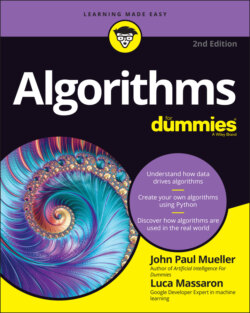Читать книгу Algorithms For Dummies - John Paul Mueller, John Mueller Paul, Luca Massaron - Страница 44
Using a heuristic and a cost function
ОглавлениеFor some people, the word heuristic just sounds complicated. It would be just as easy to say that the algorithm makes an educated guess and then tries again when it fails. Unlike brute-force methods, heuristic algorithms learn by iteratively trying to improve the solution over time. They also use cost functions to make better choices. Consequently, heuristic algorithms are more complex, but they have a distinct advantage in solving complex problems. As with brute-force algorithms, there are many heuristic algorithms, and each comes with its own set of advantages, disadvantages, and special requirements. The following list describes a few of the most common heuristic algorithms:
Pure heuristic search: Expands nodes in order of their cost. It maintains two lists. The closed list contains the nodes it has already explored; the open list contains the nodes it must yet explore. In each iteration, the algorithm expands the node with the lowest possible cost. All its child nodes are placed in the closed list and the individual child node costs are calculated. The algorithm sends the child nodes with a low cost back to the open list and deletes the child nodes with a high cost.
A * search: Tracks the cost of nodes as it explores them (and choosing the least expensive ones) using this equation: f(n) = g(n) + h(n), wheren is the node identifier.g(n) is the cost of reaching the node so far.h(n) is the estimated cost to reach the goal from the node.f(n) is the estimated cost of the path from n to the goal.
Greedy best-first search: Chooses the path that is closest to the goal using the equation f(n) = h(n). It can find solutions quite quickly, but it can also get stuck in loops, so many people don't consider it an optimal approach to finding a solution.
